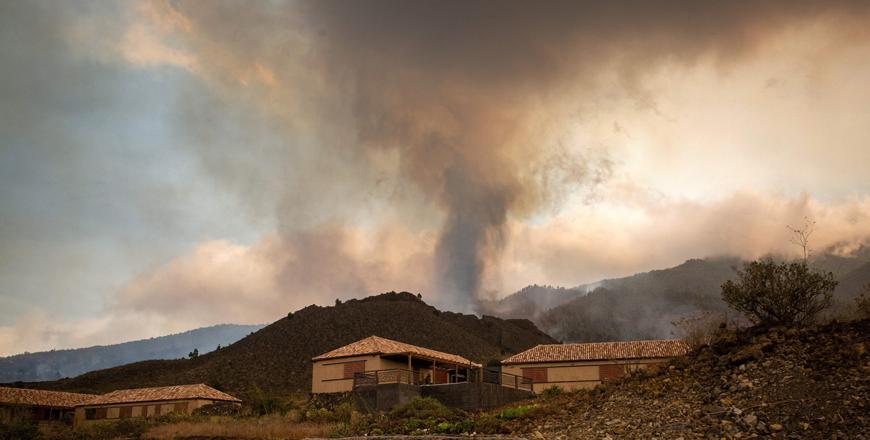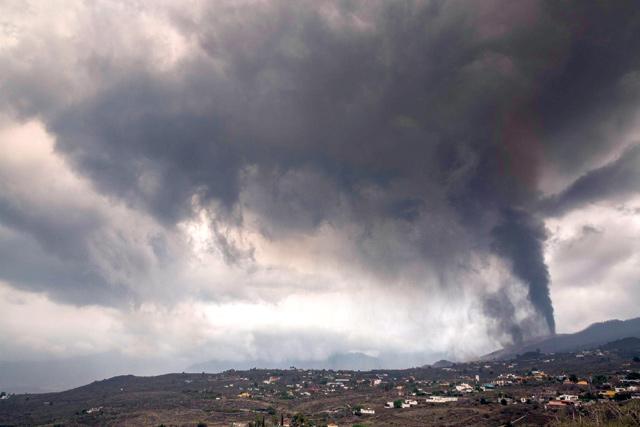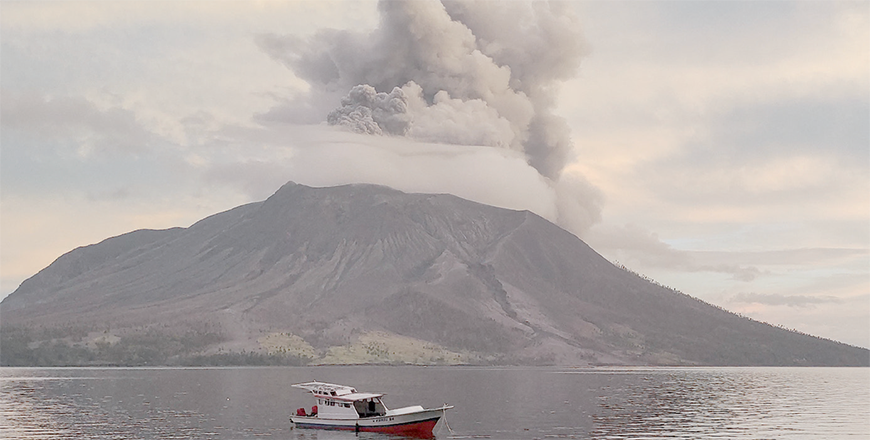You are here
Lava engulfs 100 homes as Canary Islands volcano erupts
By AFP - Sep 20,2021 - Last updated at Sep 20,2021

Smoke rises from cooling lava in the residential area of Los Campitos at Los Llanos de Aridane, on the Canary Island of La Palma, on Monday (AFP photo)
LOS LLANOS DE ARIDANE, Spain — A surge of lava destroyed around 100 homes on Spain’s Canary Islands a day after a volcano erupted, forcing 5,000 people to leave the area, local authorities said on Monday.
The Cumbre Vieja erupted around 3:00pm (14:00 GMT) on Sunday, sending vast plumes of thick black smoke into the sky and belching molten lava that oozed down the mountainside on the island of La Palma.
The island is one of the most westerly of the Atlantic archipelago off the coast of Morocco.
“Right now we have evacuated 5,000 people and around 100 homes have been destroyed,” said Lorena Hernandez Labrador, a councillor in Los Llanos de Ariadne, a town several kilometres from the volcano.
Images on Twitter showed slow-moving lava creeping down the mountainside, pockets of flame erupting as it rumbled ever closer towards a group of homes standing just metres away.
Elsewhere, piles of glowing lava surged onto the patio of a house.
Describing the scene as “desolate”, La Palma’s top official Mariano Hernandez Zapata said the lava “on average about six metres high”.
“This tongue of lava is engulfing everything in its path. It’s tragic to see how many homes have just gone up in smoke,” he told Spain’s public television.
It also consumed a local primary school where 25 children were enrolled, the headmistress told Cadena Ser radio.
“Up to about two hours ago, we thought it was going to be saved, but unfortunately it has been completely engulfed. It’s totally destroyed,” said Angeles Nieves, her voice breaking.
There was huge anguish among the thousands of people evacuated from their homes, with many wondering if they would have anything to go back to.
‘You have three minutes’
“Right now, we’re watching the news and the lava is 700 metres from our home. I’m really worried because we don’t know I don’t know what’s going to happen to it,” Angie Chaux, 27, who left with her husband and three-year-old son, told AFP.
“The police gave us three minutes to get our things. It was all very fast.”
La Cumbre Vieja straddles a ridge in the south of La Palma, which is home to around 80,000 people.
Experts had been keeping a close watch on the volcano after observing a recent upsurge in seismic activity and magma displacements.
An “earthquake swarm” — a sequence of seismic events occurring over a short period — began on September 11.
Since then, there have been tens of thousands of tremors, the strongest with a magnitude of nearly four, the Involcan volcanology institute said.
The last eruption on La Palma was in 1971 when another part of the same volcanic range — a vent known as Tenegia — erupted on the southern side of the island.
Fleeing to safety
Yahaira Garcia, 34, who runs a winery in the northwestern foothills of the volcano, decided to leave just before the eruption after a night of continuous quakes.
“My house shook so much it felt like it was going to collapse,” she told AFP, saying she had rushed over to her parents house to help them get out.
“With us we took four goats, two pigs, 20 chickens, 10 rabbits, four dogs and a turtle,” she said.
“The images are really disturbing. Now they are saying the volcano could continue erupting for three months.
“I haven’t slept for two nights, I can’t even shut my eyes.”
Local officials believe the lava were likely to move southwest towards inhabited and wooded areas, before reaching the coast.
According to Involcan, the lava flows were moving at about 700 metres per hour, and had a temperature of nearly 1,000ºC.
Ahead of the eruption, local authorities had urged the public to stay away from the areas surrounding the volcano.
Prime Minister Pedro Sanchez cancelled a scheduled trip to New York for the United Nations General Assembly after the eruption.
He arrived at the scene late Sunday evening to assess the situation.
The Canaries last recorded a volcanic eruption in 2011, undersea off El Hierro Island.
Related Articles
LOS LLANOS DE ARIDANE, Spain — A vast wall of molten lava creeping down the slopes of Spain’s La Palma island has now destroyed 320 building
LOS LLANOS DE ARIDANE, Spain — The lives of thousands may have been devastated by the volcano’s eruption on La Palma island, but many are st
JAKARTA — The threat from an Indonesian volcano that has erupted more than half a dozen times this week is not over, the archipelago’s top v



















